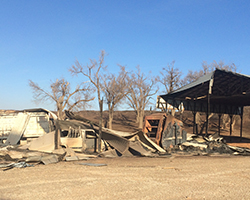Released: March 10, 2017
Following devastating property loss, documentation is key to recovery
If emotional impact is too great, ask for help

MANHATTAN, Kan. – When home and property have been lost through a natural disaster, documenting the event and compiling an inventory of lost possessions should be a priority after people and animals have been accounted for.
Spring is off to a rough start in Kansas — a series of brutal wildfires raced across southwest border counties and other areas of the state while the first tornadoes of the severe-weather season touched down in the northeast.
You may be tempted to tackle everything on your own, but there’s no better time to ask for help. Friends and family can travel to the scene to help you with several things. They can serve as valuable witnesses to the event and can help you chronicle things by capturing still images and video. And although a hotel or nearby friend can provide temporary lodging, some insurance policies provide for long-term shelter in a furnished rental property.
Before anyone begins to document what’s left of your home or business, they should get clearance from on-site disaster response teams, firefighters or Federal Emergency Management Agency (FEMA) personnel. Don’t enter any structure that has been deemed unsound or unsafe. Anyone taking part in this operation should wear any protective clothing they can get, including heavy boots, gloves, protective eyewear and a hardhat or helmet if one is available.Don’t rely on your memory for important details — record or write down the specifics as soon as you can, such as:
- What happened?
- When did it start?
- When did it end?
- Who was there?
- What kind of damage was sustained?
- What will be the cost of repairs and replacement?
As you work your way through the next several days, keep a small notebook and a couple of pens or pencils with you. No matter how reliable you may think your phone is, no matter how tech-savvy you are, a “hard copy” may be your best friend in trying times. Keep track of phone calls (date and time), what was discussed, names of insurance agents, disaster officials, members of volunteer organizations, and anyone that you meet for the first time.
All these notes, as well as any and all receipts will need to be kept in a cool, dry place. The pockets of your pants or jeans could get hot and humid, making these precious documents unreadable. Find, borrow or ask a friend to purchase for you a binder with plastic sleeves, a plastic accordion file, as well as plastic food-storage bags that can be closed tightly.
It’s not uncommon for charitable organizations, relief agencies and especially churches to show up with free supplies, following a major disaster. Feel free to accept these items when you need them — you can always pay it forward with a donation later.
K-State Research and Extension has a free publication, “Get Financially Prepared: Take Steps Ahead of Disaster,” that offers helpful information for both before and after a disaster. It’s available through your nearest Extension office, or download it here: http://www.bookstore.ksre.ksu.edu/pubs/MF3055.pdf
-30-
K‑State Research and Extension is a short name for the Kansas State University Agricultural Experiment Station and Cooperative Extension Service, a program designed to generate and distribute useful knowledge for the well‑being of Kansans. Supported by county, state, federal and private funds, the program has county Extension offices, experiment fields, area Extension offices and regional research centers statewide. Its headquarters is on the K‑State campus in Manhattan.
Story by:
Randall Kowalik
rkowalik@ksu.edu
K-State Research and Extension
http://www.ksre.ksu.edu
